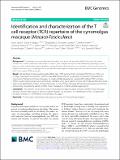Identification and characterization of the T cell receptor (TCR) repertoire of the cynomolgus macaque (Macaca Fascicularis)
Author(s)
Jaiswal, Swati; Nyquist, Sarah K.; Boyce, Shayla; Jivanjee, Tasneem; Ibrahim, Samira; Bromley, Joshua D.; Gatter, G. J.; Gideon, Hannah; Patel, Kush; Ganchua, Sharie K.; Berger, Bonnie; Fortune, Sarah M.; Flynn, JoAnne L.; Shalek, Alex K.; Behar, Samuel M.; ... Show more Show less
Download12864_2022_Article_8867.pdf (4.799Mb)
Publisher with Creative Commons License
Publisher with Creative Commons License
Creative Commons Attribution
Terms of use
Metadata
Show full item recordAbstract
Abstract
Background
Cynomolgus macaque (Macaca fascicularis) is an attractive animal model for the study of human disease and is extensively used in biomedical research. Cynomolgus macaques share behavioral, physiological, and genomic traits with humans and recapitulate human disease manifestations not observed in other animal species. To improve the use of the cynomolgus macaque model to investigate immune responses, we defined and characterized the T cell receptor (TCR) repertoire.
Result
We identified and analyzed the alpha (TRA), beta (TRB), gamma (TRG), and delta (TRD) TCR loci of the cynomolgus macaque. The expressed repertoire was determined using 22 unique lung samples from Mycobacterium tuberculosis infected cynomolgus macaques by single cell RNA sequencing. Expressed TCR alpha (TRAV) and beta (TRBV) variable region genes were enriched and identified using gene specific primers, which allowed their functional status to be determined. Analysis of the primers used for cynomolgus macaque TCR variable region gene enrichment showed they could also be used to amplify rhesus macaque (M. mulatta) variable region genes.
Conclusion
The genomic organization of the cynomolgus macaque has great similarity with the rhesus macaque and they shared > 90% sequence similarity with the human TCR repertoire. The identification of the TCR repertoire facilitates analysis of T cell immunity in cynomolgus macaques.
Date issued
2022-09-12Department
Massachusetts Institute of Technology. Department of Mathematics; Massachusetts Institute of Technology. Institute for Medical Engineering & SciencePublisher
BioMed Central
Citation
BMC Genomics. 2022 Sep 12;23(1):647
Version: Final published version